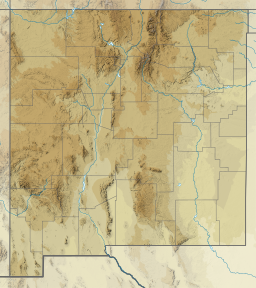Heron Lake (New Mexico)
This article does not cite any sources. (July 2012) |
| Heron Lake | |
|---|---|
 Heron Lake  Heron Lake | |
| Location | Rio Arriba County, New Mexico |
| Coordinates | 36°41′N 106°41′W / 36.69°N 106.69°WCoordinates: 36°41′N 106°41′W / 36.69°N 106.69°W |
| Type | reservoir |
| Basin countries | United States |
| Max. length | 4 mi (6 km) |
| Max. width | 3 mi (5 km) |
| Surface area | 5,900 acres (24 km2) |
| Water volume | 401,000 acre-feet (495,000,000 m3) |
| Surface elevation | 7,186 feet (2,190 m) |

Heron Lake is a reservoir in Rio Arriba County, in northern New Mexico in the southwestern United States. The lake is part of the San Juan-Chama Project, which transfers water from the upper reaches of the San Juan River through the 12.8-mile (20.6 km) Azotea Tunnel (and under the Continental Divide), into Willow Creek and the Rio Chama (and ultimately into the Rio Grande). Lake Heron is 80 miles northwest of Santa Fe.
Water is impounded in Heron Lake by the 1,250-foot (380 m) long, 263-foot (80 m) high Heron Dam, which was completed in 1971. The 5,900-acre (24 km2) lake is approximately 4 miles (6 km) long and 3 miles (5 km) wide, and lies at an elevation of up to 7,186 feet (2,190 m). Heron Dam is owned and operated by the United States Bureau of Reclamation.

The southern shore is the location of Heron Lake State Park, featuring over 200 camping and picnic sites, and two improved boat ramps. The lake is a destination for salmon and trout fishing, as well as for small boat sailing. Boat speeds are restricted by a 'no-wake' policy. A 5.5-mile (8.9 km) hiking trail crosses the Rio Chama Gorge via a pedestrian suspension bridge, and then runs southwest through wooded terrain to the grounds of El Vado Lake State Park.
The lake, dam, and state park are named after Kenneth A. Heron, an engineer in the early 1900s who realized that water could be diverted from wetter areas to the north, to the benefit of more arid regions to the south.
External links[]
- Reservoirs in New Mexico
- State parks of New Mexico
- Parks in Rio Arriba County, New Mexico
- Lakes of Rio Arriba County, New Mexico